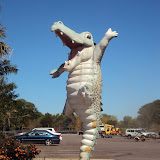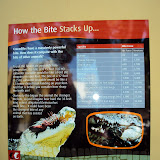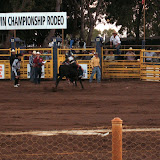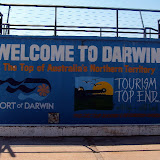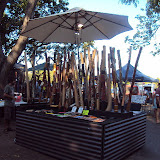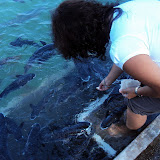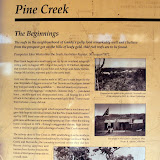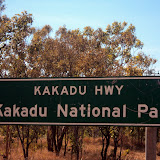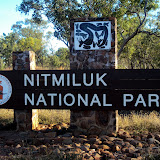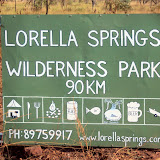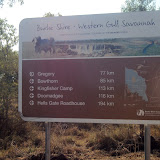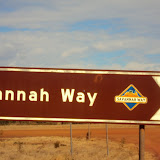We stopped at Mataranka and went to the hot springs, it was a beautiful place and the water temperature was fantastic, we also went to see Elsey’s Homestead and the Historical Characters of her book and her movie “We of the Never Never”
We also noticed the fridge was making funny noises, we could not find anyone to give it a look so we head back to Katherine, we tried to contact the agent from Dometic without any luck, Gabriel was very upset and decided to keep on travelling, he was not happy at all.
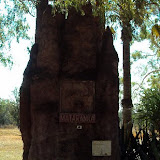 |
| Mataranka, NT |
On the road again to Daly Waters, the temperature was 32 degrees at night and no air conditioning; we arrived to the roadhouse just in time to order dinner. We set up camp and went to have a drink and eat the famous Barra'n'Beef; it was delicious, we had few drinks. One of the waitresses was from Argentina on a working visa, we had a chat with her and we meet some travellers at the pub.
The pub section was fantastic, we found a big collection of everything that you cannot imagine including used bra’s, G-strings, a tree made out of very old thongs, driver’s licenses, money bills from all over the world. We had to contribute with something to the collection, Rosario found a box with Mexican tortillas, that she brought from Mexico the last time she was there, she found a good place to put the box with our names and leave it at the pub.
 |
| Daly Waters, NT |
The next day we left Daly Waters and headed to Three Ways Road House, arriving at around 1:30 pm, there was nothing to do or see (except the pub), so we had lunch at the pub and kept on going, we decided to go non- stop all the way to Alice Springs, stopped at Tennant Creek to re-fuel and kept on going.
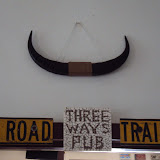 |
| Three Ways, NT |
We found Devils Marbles, the photos we have always seen about this place were with only two rocks but we found a lot of immense round rocks and the views were amazing.
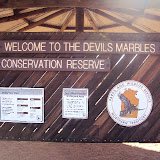 |
| Devil's Marbles, NT |
We noticed the outside temperature was dropping very fast it was getting cold; we stopped and changed from shorts and t-shirt to trousers and jumpers, unbelievable we went from hot summer (36 degrees) to cold winter (7 degrees) in less than 12 hours; arrived to Alice Springs around 8:30 pm and Gabriel said “I think I prefer the Northern Territory rather than the Southern Territory, why don’t we go back, it’s too cold”
The next day we went to the information centre and visited the Flying Doctor Service offices, it was just amazing hearing how they work and help lots of people that live in very remote areas.
 |
| Royal Flying Doctor, Alice Springs |
We also went to the Alice Springs Telegraph Station a gentleman (half aborigine and about 75 years old) introduced himself and pointed out some small kids on a photo and told us he was one of them; and that he was part of the stolen generation. He gave us a very good understanding explanation what happened with those children because he grew up in this place. He became our private guide and told us a lot of anecdotes and explained us a lot of things about the history of this place and Alice Springs, we even bought his book and he signed it for us.
Alice Springs Telegraph Station is the era’s most intact. It is midway along the Overland Telegraph Line from Darwin to Adelaide, in January 1872; the Station’s first telegraph message was transmitted to Adelaide from here.
By 1900, this very isolated Station was home to a cook, a blacksmith-stockman, four linesmen-telegraph operators plus the Station Master and his family.
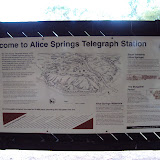 |
| Old Telegraph Station, Alice Springs, NT |
The following day we went to get the fridge and the air conditioning fixed, there was a complete electricity blackout in all of Alice Springs, the fridge could not get fixed because of problems with the manufacturer. We decided to forget about the fridge and solve the problem when we get back to Sydney. Then after we went to get the air conditioning fixed, we had to leave the caravan with them because the lack of electricity, meanwhile we went shopping, later in the afternoon we went to pick up the caravan, and back home.
Our plans were to leave Alice Springs on Saturday early morning, therefore on Friday (27 September) we went to re-stock and later went to visit the Desert Park, in this place we were able to see how much life can be found in the Australian deserts, including fauna and flora.
We were walking towards the coffee shop to have some lunch at the Desert Park when suddenly Rosario tripped over and fell down, her right arm was hurting a lot, and we went straight away to the park’s office asked for help, the first aid officer splinted her arm, but Rosario still was in a lot of pain.
It was decided to take her to the hospital in Alice Springs, the first aid officer offered to take her to the hospital in her car because she knew the way and also her car was going to be more comfortable for Rosario (Gabriel was going to follow them in the four wheel drive).
The pain was so intense and before leaving the carpark they stopped and called an ambulance, which arrived 15 minutes later and took Rosario to the hospital.
At the hospital they did some x-rays and found she had a broken bone between the thumb and the index finger and another broken bone at the end of the elbow, they put a cast on her arm and told her to come back to the hospital by Friday (3 September) to have the cast removed some x-rays and if the bone located at the elbow was ok then they were going to put a cast from the mid-arm towards the hand, which has to stay there for 6-8 weeks.
We left the hospital at around 8 pm and due that we did not have lunch we went and had some take away food and back to the caravan park.
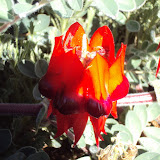 |
| Desert Park, Alice Springs, NT |
At the end we thought it was better to stay in Alice Springs and not taking the risk of been caught without medical services out in a remote area. We preferred to wait for the doctor's approval to travel and if approved we will continue our trip to Kings Canyon on Saturday 4 September.
On Saturday we had to stay at the caravan park because Rosario was in a lot of pain, taking pain killers and in bed.
On Sunday we had pancake breakfast provided by the caravan park and went to watch the trucks parade organised by the National Road Hall of Fame Reunion 2010, which by the way it supposed to be the biggest ever gathering of road transport identities ever held in Australia, we heard that during the parade there were more than 600 vehicles.
 |
| Truck Parade, Alice Springs, NT |
So here we are stuck in Alice Springs.


